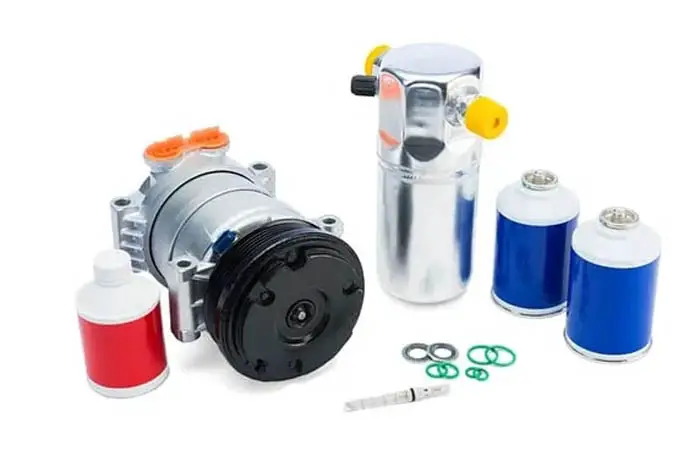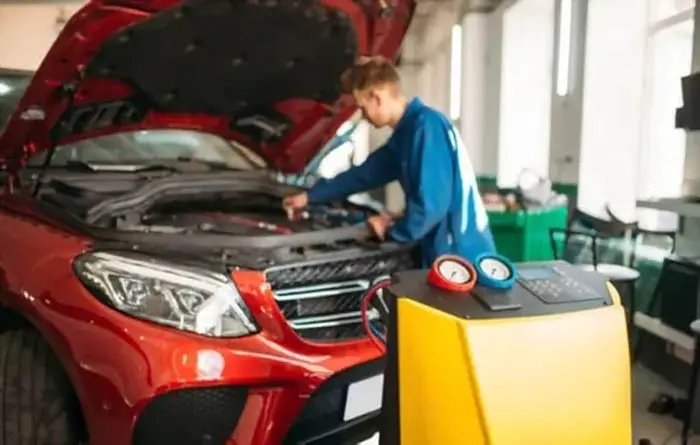
If the air in the cabin is not cool as it used to be while the AC is ON, then there is a maximum chance that refrigerant escaped from the system. A reduction in refrigerant will not let the AC perform at full capacity. To bring the AC system back to its maximum efficiency, AC needs to be recharged.
Fortunately, with the right tools and materials, recharging a car AC system is surprisingly simple. In this powerful article, we will cover all the steps necessary to properly recharge your car AC system including the pressure chart, so that you can stay cool in the summer heat.
Related Post: How To Fix Car AC Compressor Clutch Not Engaging
Understanding Your Car’s AC System
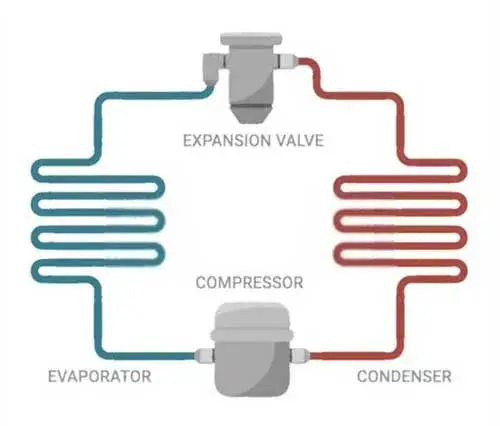
A car air conditioner works by fulfilling two specific tasks through a low-pressure and high-pressure stage. The first task is to cool the cabin ambiance, making it comfortable for the occupants. The five essential parts of a car A/C system are the compressor, condenser, evaporator, receiver-dryer, and expansion valve that cools the air.
The primary principle involved in a car A/C is heat-exchange, similar to a room air-conditioner or a refrigerator. The refrigerant enters the condenser as a pressurized gas from the compressor and then moves to the evaporator, where it cools and dehumidifies the air before distributing it throughout the cabin.
Overall, the car air conditioning system is a set of components that work together to provide a comfortable and refreshing breeze during those long summer drives.
Signs That Your Car’s AC Needs Recharging
Here are some signs that your car’s AC needs recharging:
- Warm Air Blowing from the Vents: If the air coming out of your car’s AC vents isn’t as cold as it used to be or if it’s warm, it could be a sign that the refrigerant needs to be recharged.
- Reduced Airflow: If you notice that the airflow coming from the vents is weak or reduced, it could be an indication that the refrigerant levels are low.
- Unusual Noises: If you hear strange noises coming from the car’s A/C system, such as hissing or bubbling sounds, it could be due to low refrigerant levels.
- A/C System Cycles Frequently: If the car’s A/C system turns on and off frequently or seems to struggle to maintain a consistent temperature, it could be a sign that the refrigerant levels are low.
- Foul Odors: If you notice a musty or foul smell coming from the vents when the AC is turned on, it could be due to mold growth in the A/C system caused by low refrigerant levels.
How To Recharge Your Car Air Conditioner
Step-By-Step Procedure
This guide consists of recharging the car A/C system with refrigerant r-134a. Here’s how to recharge the car A/C step-by-step.
Step 1. Inspect The Entire System
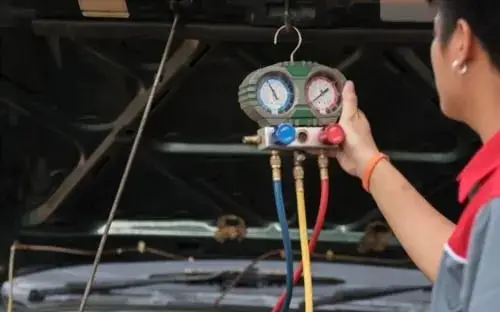
- Before recharging AC system, inspect all the auto parts of this system. Inspect for leaks, check the pressure, damaged pipes, and loose bolts.
- Make sure the compressor is working perfectly.
- Look for AC components that they do not touch so that they do not rub and eat away from each other.
This is an Info
Recharging the car A/C is a temporary fix, you should fix the underlying problem before recharging.
This is an Info
If the AC compressor’s clutch engages, it means the A/C system is low on refrigerant, provided that the AC is blowing slightly cool air. If the AC compressor’s clutch does not engage, it means the A/C system has too low refrigerant or any automotive component like the compressor has failed or there is an electrical issue.
Related Post: Parts of Car AC System
Step 2. Be Save

Always wear safety glasses before ac repair as refrigerant is unsafe for the eyes. Also, wear gloves and read all instructions written on your ac recharge kit.
Step 3. Locate The Low-Pressure Port
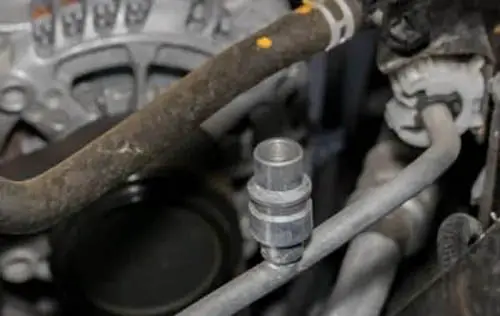
Before finding the low-pressure port, you need to know the background of the pressure pipes. There are two types of pressure lines, high and low-pressure lines. Remember, never use a high-pressure port for filling the refrigerant in the car A/C system.
Recognize the low-pressure pipe, which is larger in diameter compared to the high-pressure pipe. The low-pressure pipe comes out of the firewall (The metal wall behind the engine) to the compressor. Trace it. It has a cap cover labeled “L”. Remove it and clean it.
Related Post: 11 Reasons Why Your AC Not Cooling
Step 4. Connect The Charging Hose
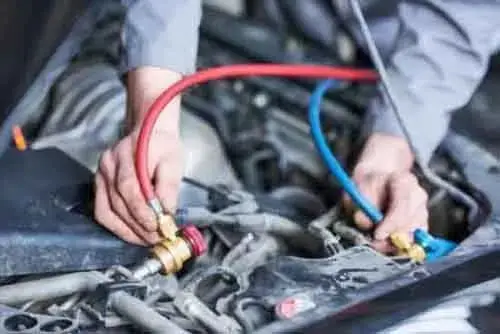
AC Recharging With Low-Pressure Port
Attach the recharge hose to the low-pressure port and tighten it.
Step 5. Run The Engine

Start the engine and press the car’s air conditioner button (inside your car). Does the compressor clutch engage? If not, it might be an indicator of low refrigerant.
If the pressure is below 20 psi, then the compressor will not engage.
Step 6. Add Refrigerant
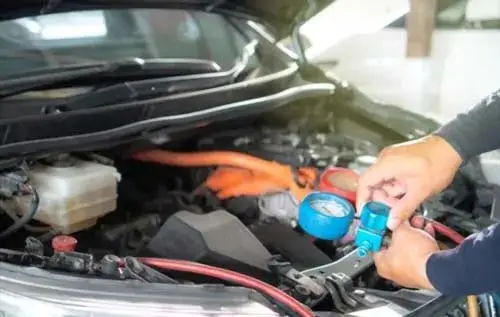
It is time to recharge the liquid refrigerant. Now connect the refrigerant tank rubber hose to the low-pressure port to recharge your car’s ac refrigerant. Continue to dispense the refrigerant for 5-10 seconds, then wait 30 seconds to add more refrigerant for the pressure to equalize. Also, keep an open eye on the pressure gauge to monitor the pressure until you get the desired level.
Almost 40 psi is enough to receive cold air. You can also take help from the below pressure chart. You have successfully refueled your car A/C, and now your car or truck’s cabin temperature must be low.
This is an Info
Be careful not to overfill the car A/C with refrigerant. It can cause damage to the air conditioning system.
This is an Info
Still, If you are not sure about how much refrigerant should be added. To recharge your car’s air conditioner, put a thermometer into the AC vent near the steering wheel, Turn On the AC, and note the temperature of almost 28 degrees Celsius is the fully charged temperature.
Car AC Recharge Pressure Chart: R134a
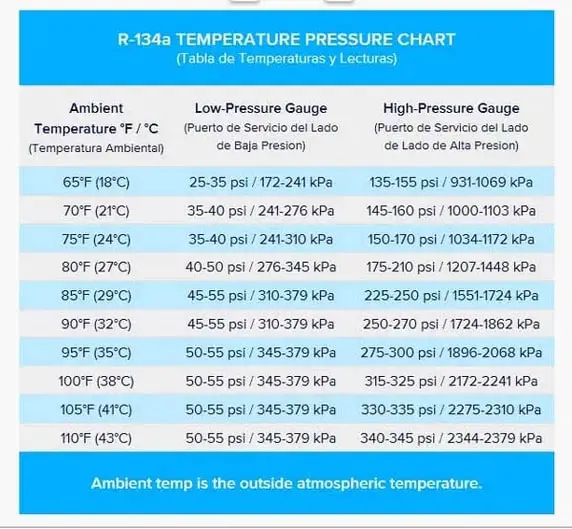
Note:
Remember:- The process of charging and recharging is the same. The difference between charging and recharging is. In charging the system, AC parts are retrofitted, the system is evacuated for 30 to 45 minutes and a proper amount of lubricating oil is added. Then the other procedure is the same, which is mentioned above.
Related Post: Car Starting System
Common Mistakes to Avoid When Recharging Your Car’s AC
When recharging your car’s A/C system, there are some common mistakes you should avoid.
- Overcharging The System: Adding too much refrigerant can damage your car’s AC compressor and other components, so it’s important to follow the manufacturer’s recommended refrigerant levels.
- Not Checking For Leaks: If you simply add refrigerant to a system with a leak, you’ll just end up wasting refrigerant and not fixing the underlying problem. It’s important to check for leaks before recharging your car’s AC.
- Using The Wrong Refrigerant: Different types of refrigerant are used in different types of A/C systems, so it’s important to use the correct type of refrigerant for your car’s specific make and model.
- Not Using Proper Safety Equipment: Refrigerant can be harmful if it comes into contact with your skin or eyes, so it’s important to wear gloves and safety goggles when handling refrigerant.
- Not Following Instructions: It’s important to follow the manufacturer’s instructions carefully when recharging your car’s AC. Skipping steps or doing things out of order can lead to costly mistakes and potentially dangerous situations.
- Ignoring Other A/C System Issues: If the A/C system is still not working properly after recharging, it’s important to have a professional mechanic or auto technician inspect the system for other issues.
Do A Mechanic Should Recharge Your AC On The High Or Low Side
Always use a low-pressure port for recharging. It is because the low side of the A/C system has less pressure and the refrigerant can easily enter the car A/C system. This will help to avoid any potential damage to your unit and will also help to maintain its efficiency.
How Often Do You Need To Recharge Car AC
A car’s air conditioning system is designed to keep your car or truck’s cabin temperature colder, and this requires the A/C system to function correctly with the right amount of refrigerant. refueling the A/C system involves adding refrigerant to the system to maintain the proper pressure, which is essential for efficient cooling especially if ac not working properly.
The frequency of refueling the A/C system depends on several factors such as the age of the vehicle, the type of refrigerant used, and the overall health of the A/C system. Leaks in the A/C system can cause the refrigerant to escape, leading to a decrease in pressure and reduced cooling capacity, requiring a recharge.
It’s important to note that the A/C system is a sealed system, and over time, it can lose refrigerant due to normal wear and tear, which can result in the need for a refuel. In general, it’s recommended to have your AC system inspected annually to check for leaks and proper pressure and perform ac repair services if necessary.
The best way to ensure your car’s A/C system is functioning properly is to have it regularly checked by a professional mechanic, who will inspect the system, check the AC pressure, and refuel the A/C system if needed. This will help to keep your A/C system running efficiently and keep you comfortable on those hot summer days.
How Much Does It Cost To Recharge Car AC
The cost of recharging the system with refrigerant can vary depending on several factors such as the type of refrigerant used, the location, and the cost of labor. On average, the cost can range from $100 to $200.
This includes the cost of the refrigerant, the cost of the recharge hose, and the cost of labor. Some factors that can affect the cost of recharging the A/C system include the type of refrigerant used, the size of the A/C system, and the complexity of the job.
It’s important to keep in mind that refueling the A/C system is just a temporary fix and if the system has a leak, it needs to be repaired first before recharging the A/C system. If not, the refrigerant will escape again, and the A/C system will need to be recharged again.
It’s recommended to recharge the system with refrigerant or have a professional mechanic to ensure that the job is done correctly and that the proper refrigerant is used. This will help to ensure the safety and efficiency of the A/C system and keep you comfortable on those hot summer days.
Conclusion
In conclusion, recharging your car’s air conditioner is a relatively easy task that anyone can do with the right equipment. With the help of an AC recharge kit, you can diagnose and fill your system with refrigerant in a matter of minutes. Be sure to wear gloves, and safety glasses, and use caution when handling and connecting components. Lastly, be sure to never mix refrigerants or overcharge the system as it could cause major damage to the vehicle’s A/C components or take your car to the shop.
Frequently Asked Questions (FAQs)
To recharge the car’s AC, find the AC and turn it on the car’s AC. Hold the can of liquid refrigerant upright and squeeze the trigger to add the refrigerant. Make sure the system is sealed well, and don’t overcharge the system. The above is how to recharge your AC and find the best AC recharging options for your car.
If you find that only warm air blows out of one of the AC vents in your car, it’s time to recharge your AC freon. Take your vehicle to a mechanic to have the AC work done, or if you’re comfortable doing it yourself, follow a guide on how to recharge your AC.
To add new freon after cleaning your A/C system in your car, make sure the system is sealed well and hold the can of new freon upright. Squeeze the trigger to add the new freon, but be careful not to overcharge the system. Follow this guide on converting your R12 system to R134a for the best results.
If you find only warm air blowing from your auto AC, it’s time to recharge your AC. Hold the can of refrigerant upright and follow a guide to show you the best AC recharging options for your car. Make sure to release the refrigerant, add new freon as well as clean the system, and avoid losing freon until the day.
Sign Up

